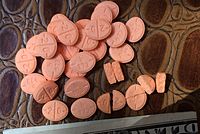Substituted amphetamine
A variety of prodrugs of amphetamine and/or methamphetamine exist, and include amfecloral, amfetaminil, benzphetamine, clobenzorex, D-deprenyl, deprenyl, dimethylamphetamine, ethylamphetamine, fencamine, fenethylline, fenproporex, furfenorex, lisdexamfetamine, mefenorex, prenylamine, and selegiline.[6] A number of synthetic Russian amphetamine derivatives have been developed, including alafen (amphetamine–β-alanine), feprosidnine, gamofen (amphetamine–GABA), mesocarb, methylphenatine, pabofen (amphetamine–PABA), phenatine (amphetamine–niacin; N-nicotinoylamphetamine), phenylphenamine (phenylamphetamine), propylphenamine (propylamphetamine), pyridoxiphen (amphetamine–pyridoxine), and thiophenatine (N-thionicotinoylamphetamine).Typical reaction is substitution by methyl and sometimes ethyl groups at the amine and phenyl sites:[8][9][10] Ephedra was used 5000 years ago in China as a medicinal plant; its active ingredients are alkaloids ephedrine, pseudoephedrine, norephedrine (phenylpropanolamine) and norpseudoephedrine (cathine).Over-the-counter use of substituted amphetamines was initiated in the early 1930s by the pharmaceutical company Smith, Kline & French (now part of GlaxoSmithKline), as a medicine (Benzedrine) for colds and nasal congestion.Subsequently, amphetamine was used in the treatment of narcolepsy, obesity, hay fever, orthostatic hypotension, epilepsy, Parkinson's disease, alcoholism and migraine.


AmphetamineAmphetamine (disambiguation)Drug classRacemic amphetamineSynonymsChemical classOptical isomersL-amphetamineD-amphetamineclass of compoundsderivativesubstitutinghydrogen atomssubstituentsstimulantsempathogenshallucinogensmethamphetamineephedrinecathinonephenterminemephenterminetranylcyprominebupropionmethoxyphenamineselegilineamfepramone (diethylpropion)pyrovaleronederivativesEphedracentral nervous systempsychoanaleptichallucinogenicempathogenicEthylamphetaminePropylamphetamineIsopropylamphetamineButylamphetaminePheniprazinePhenatineLisdexamfetaminePhenylpropanolamineCathineOrtetamine2-Fluoroamphetamine3-Methylamphetamine2-Phenyl-3-aminobutane3-FluoroamphetamineGepefrineNorfenfluramine4-Methylamphetaminepara-Methoxyamphetaminepara-Ethoxyamphetamine4-MethylthioamphetamineNorpholedrinepara-Bromoamphetaminepara-Chloroamphetaminepara-Fluoroamphetaminepara-IodoamphetamineMefenorexClobenzorexAmfetaminilAmfecloralRacefemineDextrofemineFenproporexPrenylamineFenethyllineDimethylamphetamineBenzphetamineDeprenylD-DeprenylMetfendrazinePhenpenterminePseudoephedrineMetaraminolMethcathinoneEthcathinoneClortermineMethoxymethylamphetamineFenfluramineDexfenfluramine4-Methylmethamphetaminepara-Methoxymethamphetaminepara-MethoxyethylamphetaminePholedrineChlorphenterminepara-FluoromethamphetamineXylopropamineα-Methyldopamine3,4-MethylenedioxyamphetamineDimethoxyamphetaminePhenylpropylaminopentaneFurfenorexFencamineNordefrinMethylephedrineEtafedrineOxilofrineCinnamedrineMethoxamineDimethoxybromoamphetamineDimethoxychloroamphetamineDimethoxyfluoroethylamphetamineDimethoxyethylamphetamineDimethoxyfluoroamphetamineDimethoxyiodoamphetamineDimethoxymethylamphetamineDimethoxynitroamphetamineDimethoxypropylamphetamineDimethoxytrifluoromethylamphetamineMethylenedioxyethylamphetamineMethylenedioxyhydroxyamphetamine2-Methyl-MDA5-Methyl-MDAMethoxymethylenedioxyamphetamineTrimethoxyamphetamineDimethylcathinoneDiethylcathinoneMephedroneMethedroneBrephedroneFlephedroneRitodrineBuphenineTrecadrine